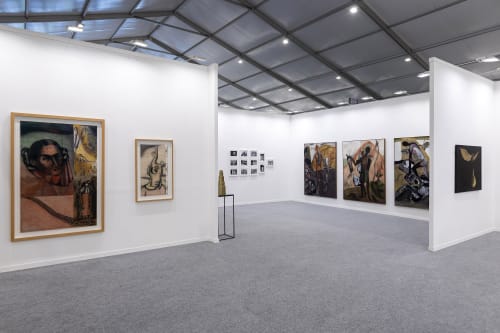 Booth B4
Booth B4
A topology might reveal a surface, but topologies of time reveal directives for depth. The temporality of art, or art’s relationship with time, is manifest even as visual art behaves atemporally, offering up its compositions completely and instantly to the viewer through narrated meaning or threaded experience. Whether actual or implied, linear or circular, like the time-travelling astronaut art is a temporal beast beset within points in space–time, connecting generations of artistic impulses and movements. We might say an artwork travels to us even as it appears to be standing still, conjuring a wormhole of relationships that at once inflate and collapse onto a point of meaning in an ever expanding universe of thought and action.
In our curation titled Time Is the Longest Distance Between Places, we explore temporality in art not only as a duration of process or movement but as a formulaic material of construction and aesthetics. We will present exciting and important works by artists across four generations from our main gallery program, including Gulammohammed Sheikh, Rameshwar Broota, A. Ramachandran, Sudhir Patwardhan, Atul Dodiya, Sunil Gupta, Anju Dodiya, N.S. Harsha, Shilpa Gupta, Biraaj Dodiya, Sachin George Sebastian, Shrimanti Saha and Shailesh B.R., among others. An inter-generational milieu when read together with purpose and intention can take on characteristics of a living zeitgeist, for influences are organic and mutable, abounding equally in history and contemporary practice and where neither are present, the imagination.
Such intersections of cultural moods and artistic excursions become earnestly conversant with each other, so much so we find expressed temporal existence – or the truth of our times – are comparably resonant in Atul Dodiya’s solitary figures negotiating search and transcendence in symbolic landscapes, in Gulammohammed Sheikh’s inspired drawings that seek to respond to current world events in real-time and in Shilpa Gupta’s cut-frames that navigate the wear and tear of borders and boundaries. In considering autobiographical time, Anju Dodiya presents an inner theatre of emotions that grapple with existential concerns and insecurities, while Sudhir Patwardhan’s studio anxieties take on a figurative character, entwining structures of place and plot with a sensibility of circumstance and Rameshwar Broota’s canonical instinct for textures appeals to an abstracted sensibility of time, a wide and ethereal vastness that carries within it all other living narratives. Historical time is negotiated similarly by Sunil Gupta and K.M. Madhusudhanan – the former’s documentary-style photographs reveal an exegesis of marginalized identity in a particular cultural moment, and the latter’s consideration of the politics of migration marks important questions about nationalities and patriotism. For Shrimanti Saha and Shailesh B.R., the world represents a collective cognition meaningfully accessed through narrative knowledge and objects, a world of positivity granted through an abstract source, while for Biraaj Dodiya abstraction remains the dominant perspective with which to encapsulate questions of truth and presence.
